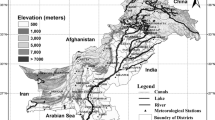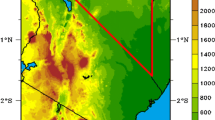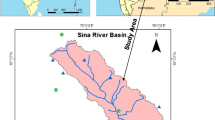Abstract
Drought is a slow-onset, creeping natural hazard and a recurrent phenomenon in the arid and semi-arid region of the Mekerra watershed. Numerous drought indices have been used in different countries to implement drought mapping and monitoring of water resources management. This investigation proves meteorological drought index combined with remote sensing drought index, but had unsteady spatial and temporal variation.
The results highlight that droughts occur in semi-arid climatic region of Sidi Bel Abbes at the Northern part of the watershed. The various drought indices differ in their detection and classification of this extreme climatic event in the study area. There is high correlation (r > 0.68) among the eight indices, with PD (Precipitation deciles), DI (Deciles Index), and PNI (Percent of Normal Index) showing the highest relationship to SPI (r = 0.95 and r = 0.99 respectively). The differences observed among the drought indices in detecting drought events in the study area can be reduced by using multiple drought indices in addition to the use of SPI (Standardized Precipitation Index) in drought assessments especially at the area of Sidi Bel Abbes since technological advancement in drought monitoring software’s has made it easier. In addition, it is worthwhile to investigate on why drought detection varies with indices. Furthermore, considering the advantages and disadvantages of the mentioned drought predictors in this study area will enhance the understanding of vegetation responses to drought threatens.





Similar content being viewed by others
References
Abbes M, Hammed A, Lafride A, Laounia N, Mahi H (2018) Use of high spatial resolution satellite data for monitoring and characterization of drought conditions in the Northwestern Algeria. Min Sci 25:85–113. https://doi.org/10.5277/msc182507
Alley WM (1984) The Palmer drought severity index: limitations and assumptions. J Appl Meteorol 23:1100–1109. https://doi.org/10.1175/1520-0450(1984)023<1100:TPDSIL>2.0.CO;2
Bento V, Gouveia C, Dacamara A, Carlos CC, Trigo FF (2018) A climatological assessment of drought impact on vegetation health index. Agric For Meteorol 259:286–295. https://doi.org/10.1016/j.agrformet.2018.05.014
Besser H, Mokadem N, Redhaounia B, Hadji R, Hamad A, Hamed Y (2018) Groundwater mixing and geochemical assessment of low-enthalpy resources in the geothermal field of southwestern Tunisia. Euro-Mediterr J Environ Integr 3:16. https://doi.org/10.1007/s41207-018-0055-z
Byun HR, Wilhite DA (1999) Objective quantification of drought severity and duration. J Climatol 12:2747–2756. https://doi.org/10.1175/1520-0442(1999)012<2747:OQODSA>2.0.CO;2
Chang Y, Cesarman E, Pessin MS, Lee F, Culpepper J, Knowles DM, Moore PS (1994) Identification of herpes virus-like DNA sequences in AIDS-associated Kaposi’s sarcoma. Science 266:1865–1869. https://doi.org/10.1126/science.7997879
Dubrovsky M, Svoboda MD, Trnka M, Hayes MJ, Wilhite DA, Zalud Z, Hlavinka P (2006) Application of relative drought indices in assessing climate-change impacts on drought conditions in Czechia. Theor Appl Climatol 96:155–171. https://doi.org/10.1007/s00704-008-0020-x
Escalante-Sandoval C, Nuñez-Garcia P (2017) Meteorological drought features in northern and northwestern parts of Mexico under different climate change scenarios. J Arid Land 9:65–75. https://doi.org/10.1007/s40333-016-0022-y
Gibbs W, Maher J (1967) Rainfall deciles as drought indicators. Bureau of Meteorology, Melbourne, p 117
Hamed Y, Hadji R, Redhaounia B, Zighmi K, Bâali F, El Gayar A (2018) Climate impact on surface and groundwater in North Africa: a global synthesis of findings and recommendations. Euro-Mediterr J Environ Integr 3:1–15. https://doi.org/10.1007/s41207-018-0067-8
Heim RR (2002) A review of twentieth-century drought indices used in the United States. Bull Am Meteorol Soc 83:1149–1166. https://doi.org/10.1175/1520-0477(2002)083<1149:Arotdi>2.3.co;2
IPCC (Intergovernmental Panel on Climate Change) (2014) Working Group III Contribution to the IPCC Fifth Assessment Report Climate Change 2014: Mitigation of Climate Change. Cambridge University Press, Cambridge and New York. 895–896
Jain VK, Pandey RP, Jain MK, Byun HR (2015) Comparison of drought indices for appraisal of drought characteristics in the Ken River Basin. Weather Clim Extreme 8:1–11. https://doi.org/10.1016/j.wace.2015.05.002
Keyantash J, Dracup JA (2002) The quantification of drought: an evaluation of drought indices. Bull Am Meteorol Soc 83:1167–1180. https://doi.org/10.1175/1520-0477-83.8.1167
Kostopoulou P, Karatassiou M (2017) Lotus corniculatus L. response to carbon dioxide concentration and radiation level variations. Photos 55:522–531. https://doi.org/10.1007/s11099-016-0671-2
Li R, Tsunekawa A, Tsubo M (2014) Index-based assessment of agricultural drought in a semi-arid region of Inner Mongolia, China. J Arid Land 6:3–15. https://doi.org/10.1007/s40333-013-0193-8
Li R, Tsunekawa A, Tsubo M (2017) Assessment of agricultural drought in rainfed cereal production areas of northern China. Theor Appl Climtol 127:597–609. https://doi.org/10.1007/s00704-015-1657-x
McKee TB, Doesken NJ, Kleist J (1993) The relationship of drought frequency and duration to time scales. In: Proceedings of the 8th Conference on Applied Climatology. Am Meteorol Soc, Anaheim, 179–184
Meddi M, Hubert P (2003) Impact de la modification du régime pluviométrique sur les ressources en eau du Nord-Ouest de l'Algérie. In : Hydrology of the Mediterranean and semiarid Regions. IAHS Pub 278:1–7
Meddi M, Humbert J (2000) Variabilité pluviométrique dans l’Ouest algérien durant les cinq dernières décennies. Public Assoc Intern Climatol 13:266–274
Mokadem N, Boughariou E, Mudarra M, Ben Brahim F, Andreo B, Hamed Y, Bouri S (2018) Mapping potential zones for groundwater recharge and its evaluation in arid environments using a GIS approach: case study of North Gafsa Basin (Central Tunisia). J Afr Earth Sci 141:107–117. https://doi.org/10.1016/j.jafrearsci.2018.02.007
Morid S, Smakhtin V, Moghaddasi M (2006) Comparison of seven meteorological indices for drought monitoring in Iran. Int J Climatol 26:971–985. https://doi.org/10.1002/joc.1264
Ncibi K, Chaar H, Hadji R, Baccari R, Sebei A, Khelifi F, Abbes M, Hamed Y (2020) A GIS-based statistical model for assessing groundwater susceptibility index in shallow aquifer in Central Tunisia (Sidi Bouzid basin). Arab J Geosci 13:98. https://doi.org/10.1007/s12517-020-5112-7
Potop V, Boroneant C, Možný M, Štěpánek P, Skalák P (2014) Observed spatiotemporal characteristics of drought on various time scales over the Czech Republic. Theor Appl Climatol 115:563–581. https://doi.org/10.1007/s00704-013-0908-y
Quiring SM (2009) Developing objective operational definitions for monitoring drought. J Appl Meteorol Climatol 48:1217–1229. https://doi.org/10.1175/2009JAMC2088.1
Salehnia N, Alizadeh A, Sanaeinejad H, Bannayan M, Zarrin A, Hoogenboom G (2017) Estimation of meteorological drought indices based on AgMERRA precipitation data and station-observed precipitation data. J Arid Land 9:797–809. https://doi.org/10.1007/s40333-017-0070-y
Shahabfar A, Eitzinger J (2013) Spatio-temporal analysis of droughts in semi-arid regions by using meteorological drought indices. Atmos 4:94–112. https://doi.org/10.3390/atmos4020094
Surendran U, Kumar V, Ramasubramoniam S, Raja P (2017) Development of drought indices for semi-arid region using drought indices calculator (DrinC)–a case study from Madurai District, a semi-arid region in India. Water Resour Manag 31:3593–3605. https://doi.org/10.1007/s11269-017-1687-5
Talia A (2003) Evolution of pluviometric and hydrological regimes in northern Algeria. Thesis Dissertation, University of Mascara
Tigkas D, Vangelis H, Tsakiris G (2013) The RDI as a composite climatic index. Eur Water 41:17–22
Tsakiris G, Vangelis JEW (2005) Establishing a drought index incorporating evapotranspiration. Eur Water 9:3–11
Tsakiris G, Pangalou D, Vangelis H (2007) Regional drought assessment based on the reconnaissance drought index (RDI). Water Resour Manag 21:821–833. https://doi.org/10.1007/s11269-006-9105-4
Van-rooy MP (1965) A rainfall anomaly index independent of time and space. Notos 14:43–48
Wang YF, Liang LS, Jing JL, Luo FL, Wang AN (2020) Characteristic of drought and flood in the Dian-Qian-Gui karst areas based on TRMM-Z Index. Int Arch Photogramm Remote Sens Spat Inf Sci XLII-3/W10:917–924. https://doi.org/10.5194/isprs-archives-XLII-3-W10-917-2020
Willeke G, Hosking JRM, Wallis JR et al (1994) The national drought atlas. In: Institute for Water Resources Report 94-NDS-4. U.S Army Corp of Engineers, CD-ROM
WMO (World Meteorological Organization) 2013 High-level Meeting on National Drought Policy. Geneva: International Conference Center (CICG). [2013-03-11]. http://www.wmo.int/pages/prog/wcp/agm/meetings/hmndp13/. Accessed Feb 2012
WMO (World Meteorological Organization), Global Water Partnership (GWP) (2016) Handbook of Drought Indicators and Indices. Integrated Drought Management Program (IDMP), Integrated Drought Management Tools and Guidelines. Series, 2
Wu H, Hayes MJ, Weiss A, Hu Q (2001) An evaluation of the standardized precipitation index, the China-Z index and the statistical Z-score. Int J Climatol 21:745–758. https://doi.org/10.1002/joc.658
Author information
Authors and Affiliations
Corresponding author
Ethics declarations
Conflict of interest
The authors declare that they have no competing interests.
Additional information
Responsible Editor: Zhihua Zhang
Rights and permissions
About this article
Cite this article
Elhoussaoui, A., Zaagane, M. & Benaabidate, L. Comparison of various drought indices for assessing drought status of the Northern Mekerra watershed, Northwest of Algeria. Arab J Geosci 14, 915 (2021). https://doi.org/10.1007/s12517-021-07269-y
Received:
Accepted:
Published:
DOI: https://doi.org/10.1007/s12517-021-07269-y




